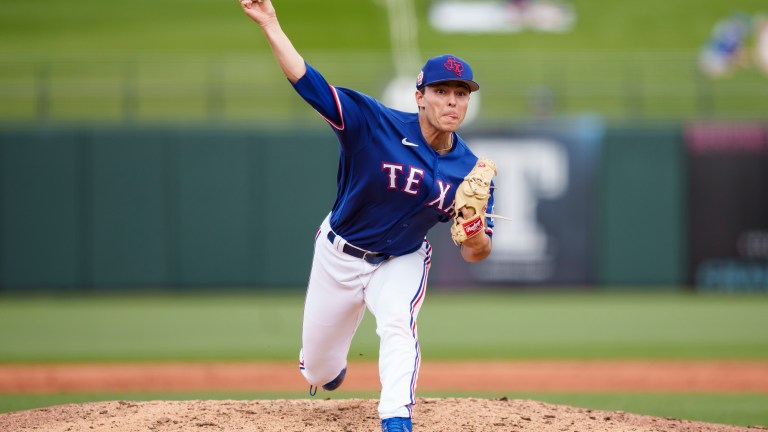Top Pitching Prospects Roundup: Jack Leiter and Tink Hence Continue Hot Starts
Another look into some of the best starts we saw in the minor leagues this past week, from the top pitching prospects in the game.

The second edition of our weekly top pitching prospect roundup is a combination of emergent arms as well as longtime highly regarded arms who look to be returning to form. It’s early, but Rangers prospect Jack Leiter has looked a lot more like the No. 2 overall pick in the 2021 draft since the start of Spring Training, while Cardinals prospect Tink Hence is reminding us just how talented he is on the mound through his first two starts.
Emergent arms like Phillies sixth rounder George Klassen and Jonah Tong of the Mets were a lot of fun to dive into and I wanted to give the reliever community some love with Reds flamethrower Zach Maxwell. You can usually expect around 10-12 pitchers mentioned, with a handful more names ranging from all levels. You’ll see some repeat names mixed in because they absolutely shoved again.
Jack Leiter (Rangers Triple-A): 6 IP, 6 H, 3 ER, 0 BB, 10 K
Before you say anything about the three earned runs, it’s the PCL and I’m more focused on the command and stuff, both of which have been on a different level for Leiter since he showed up to camp. I had to check this several times, but this was Leiter’s first outing with 10 strikeouts and 0 walks since he was a junior at Delbarton high school.
Even through his domination at Vanderbilt, which included 11 outings of 10 or more strikeouts in his draft year, Leiter walked at least one. Beyond the fact that Leiter is filling up the zone more with his fastball and slider, he’s leaned into his cutter that he previously threw sparingly, giving him a third look he can command consistently if the curveball is not there.
That said, it was fastball domination for Leiter, picking up 13 whiffs on his fastball, along with 11 more called strikes. He touched 98 mph plenty, averaging 96.7 mph in the 83-pitch outing. Leiter has now punched out 25 batters in 14 1/3 innings of work with all six of his earned runs coming via the long ball, something that comes with the territory of the Pacific Coast League.
Now set to make his highly anticipated big league debut on Thursday, Leiter is riding plenty of momentum.
Paul Skenes (Pirates Triple-A): 3.1 IP, 0 H, 0 ER, 1 BB, 8 K
Well, he did it again. Pure dominance from the Pirates top prospect in his third Triple-A outing. It’s a slow build up, with Skenes only throwing 55 pitches in this outing, after averaging 45 pitches through his first two, but the flame-throwing right-hander looks eager to stretch out further. In fact, he went and threw a 15 pitch bullpen right after he came out of the game.
Skenes averaged 100.4 mph on his fastball, touching 102 mph, though it’s not just the sheer velocity that made him so impressive yet again. While you wouldn’t know it by the stat line, Skenes was a bit inconsistent with his slider through the first two outings, mostly putting hitters away with his fastball and power changeup.
In Friday’s outing, Skenes landed 10 of his 14 sliders for a strike, a large improvement from his 46% strike rate on the pitch through his first two outings. Skenes discussed how he has manipulated his slider more as a pro to get away from just the sweeper, throwing multiple variations at slightly different speeds and shapes. With him now looking more comfortable locating his slider, it seems like the only thing standing in between Skenes and PNC Park is build up.
Christian Scott (Mets Triple-A): 5 IP, 2 H, 1 ER, 1 BB, 10 K
Scott followed up a strong Triple-A debut with a phenomenal second start. He was more efficient, limited damage and had all three offerings working for him. It goes without being said at this point that Scott is going to get whiffs with his fastball and his changeup was his preferred weapon off of it last year. His new slider adds another dimension to his arsenal and he utilized the three pitch mix somewhat unconventionally.
In this outing in particular, Scott actually threw more changeups than sliders to righties, keeping them guessing. He mixed his slider and changeup equally to righties, looking as confident as can be with the former. Scott poured in strikes at a 70% clip overall with 13 of his 15 sliders for strikes.
After hanging two sliders in his previous outing that resulted in homers, the lone run came from a 2-1 fastball that ran back over the middle of the plate to Nathan Hickey. He averaged 95 mph with his fastball and held it deep into his start, touching 96 mph on his final pitch. Scott is yet another big league ready arm sitting in Triple-A.
Adam Mazur (Padres Double-A): 6 IP, 3 H, 0 ER, 0 BB, 4 K
It has been a fantastic start to the season for the Padres right-handed pitching prospect, allowing just one earned run in 11 innings of work with 12 strikeouts against one walk. Still not fully stretched out, the efficiency of Mazur is what really stands out.
Despite only throwing 53 pitches, Mazur was able to toss six scoreless; that’s an average of 8.8 pitches per inning. Doing his own version of a Maddux, Mazur has needed just 109 pitches to get through his 11 innings of work this year.
While his fastball does not have the best characteristics, Mazur sits in the mid 90s and hits his spots effectively. Both his slider and curveball were consistently working for him with a couple changeups sprinkled in. Mazur already had elite command of his slider dating back to last season, posting a 73% strike rate on the pitch, but the curveball and changeup were not always there for him, combining for a 58% strike rate.
In the early going this year, Mazur has been landing his third and fourth pitches for a strike more than 75% of the time, giving him a true quartet of offerings that hitters have to respect. It will be interesting to see if Mazur can hold his velocity as he stretches back out.
Tink Hence (Cardinals Double-A): 5 IP, 3 H, 1 ER, 0 BB, 8 K
Another repeat name, Hence followed up his five hitless innings in his first start with five innings of one run ball and more whiffs his second time out. After throwing 67 pitches in April 5th, Hence stretched out to 82 pitches last outing, mixing his fastball, breaking balls and changeup well.
He racked up an impressive 17 swinging strikes: 10 on breaking balls, four on changeups and three on fastballs. After struggling with heavy fastball reliance last season, Hence has found an improved feel for his mid 80s slider and 78-82 mph curveball. Even though changeup is still somewhat hit or miss, his ability to go to either breaking ball consistently takes some pressure off of the change when it is not totally there and his last outing was a perfect example.
That said, he mixed in some good changeups and continues to pick up plenty of weak contact on the heater even if he isn’t grabbing whiffs in droves. Hence looks as good as he has looked in a while.
Jackson Jobe (Tigers Double-A): 3.1 IP, 2 ER, 4 BB, 5 K
A change of pace here as we check in on a top pitching prospect who is struggling, Jobe has now uncharacteristically walked seven batters in his 5 2/3 innings of work. For reference, Jobe walked six batters in 64 innings of work last season after returning from injury.
It’s still early and the top ranked pitching prospect‘s stuff has still been there, picking up plenty of whiff with his upper 90s fastball and slider. The secondaries have just not been there from a consistency standpoint, landing non-fastballs for a strike at just a 51% clip.
I’ll side with the nearly 1,200 pitch sample we have of Jobe racking up strike rates of 65% across each of his offerings in 2023.
If the trend continues, it will definitely be worth diving into further, but two shaky cold weather starts for a Texas kid after a year in which he boasted some of the best command in the Minor Leagues is just not enough to sound the alarms yet. Especially when the fastball command has been there and the “feel” pitches have not so far.
Zach Maxwell (Reds Double-A): 3.2 IP, 0 H, 0 ER, 1 BB, 9 K
A reliever sighting! It takes some loud stuff to make the pitching roundup as a reliever and Maxwell possesses just that. Through three appearances so far, Maxwell has yet to allow a hit and has struck out nine of the 12 batters he has faced.
Possessing one of the best fastballs in the Minor Leagues, Maxwell has averaged 99.5 mph, touching 101 mph with 20 inches of induced vertical break. That’s simply freak stuff that could work in the Reds bullpen right now. The challenge is Maxwell’s slider, which has not been there for him so far. Of course, he has not needed it against Double-A competition erasing any hitter’s count by just blowing his elite fastball by hitters.
If the 6-foot-7 right-hander can find even an above average slider, he could be a high leverage arm for the Reds sooner rather than later.
George Klassen (Phillies Low-A): 5 IP, 2 H, 2BB, 0 ER, 8 K
Viewed as a project when the Phillies took him in the sixth round of the 2023 draft, Klassen dealt with some minor ailments that would delay his pro debut until 2024. He quickly created plenty of buzz during Spring Training and has followed that up with dominance through his first two pro starts.
Klassen averaged 97 mph with his fastball his last time out, touching 99 mph with arm side run from a high three-quarters release. Put simply, Klassen appears to be too good for his Low-A competition, leaning heavily on his upper 90s fastball which has blown hitters up. There’s a lot of effort in Klassen’s delivery, which could be leading to the inconsistency with breaking balls far, but it hasn’t really mattered.
His power curve is particularly impressive when it is around the zone, giving him the potential for a second plus pitch. Klassen is surely turning heads and already looks like a steal for the Phillies in the first round. That said, he could run into some speed bumps against more disciplined hitters.
Jonah Tong (Mets Low-A): 4 IP, 1 H, 1 R (0 ER), 3 BB, 10 K
Another possible Mets scouting success out of Canada, Tong’s unique fastball characteristics in the low 90s and an intriguing breaking ball made him worth a flier for the Mets in the 7th round. Tong showed up to camp in 2024 throwing nearly two ticks harder from a slightly adjusted release point which has helped him fill up the zone more with the fastball as well as pick up more whiff.
Averaging more than 20 inches of IVB, Tong was throwing even harder in his last start, sitting 92-95 mph, touching 96 mph for the first time in his pro career. Elite ride and now inching closer to the mid 90s has made his fastball a nightmare for hitters.
The 20-year-old right-hander racked up 19 whiffs in his last outing, 12 of which came on his fastball, six more on the slider and one curveball. Previously favoring his curveball, Tong’s slider has been a difference maker as well in the early going of the season.
His fantastic 42.5% called strike and whiff rate is also a testament to his fastball freezing hitters at the knees as it defies gravity better than most fastballs. It’s early for Tong, but hard to argue against the data and results thus far.
Quinn Mathews (Cardinals Low-A): 5 IP, 1 H, 0 ER, 0 BB, 11 K
A strike-throwing lefty who infamously threw 156 pitches in his second-to-last collegiate outing for Stanford, Mathews lacked the stuff to be a day one pick, operating mostly in the low 90s with mostly average secondaries.
The 6-foot-4 starter has emerged throwing much harder in 2024, averaging 94 mph with his fastball in his first start and 95 mph in his second start where he allowed just one baserunner over five innings while punching out 11. In addition to the uptick in velocity, Mathews has averaged more than 18 inches of induced vertical break from a below average release height of just 5.6 feet and average extension.
All of the sudden a pitcher who many believed may have to hide his fastball, may have an above average one. The changeup was his best secondary in college, but it was his slider that really stood out in this outing. He piled up 18 swinging strikes, six of which on his improved slider, along with six fastball whiffs, five changeup whiffs and a swing and miss through a curveball.
It is just Low-A competition for a relatively polished collegiate arm, but the fact that Mathews is touching 97 mph, with the characteristics that he has flashed in the early going, along with a new-looked slider has me excited to keep an eye on him moving forward.

